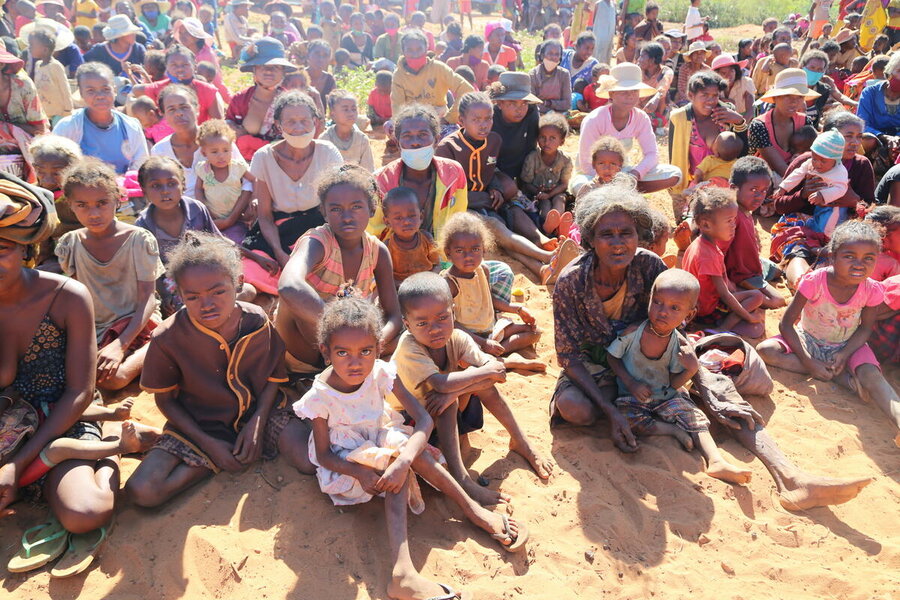WFP's plan to support 42 million people on the brink of famine
Executive summary: US$6.6 billion ask
The World Food Programme (WFP) is warning that tens of millions of people across 43 countries are on the brink of famine – and the numbers are constantly going up. Urging billionaires to step up and support the fight against hunger, the organization said U$6.6 billion would help avert catastrophe.
In 2020, in the face of the COVID-19 pandemic, WFP succeeded in reaching more than 115 million people with vital food assistance across 84 countries – the highest figure since 2012. This was only possible through the support of government donors.
With its existing operations in more than 80 countries around the world, WFP is uniquely placed to respond to the urgent needs of more than 40 million people at risk of starvation, and we stand ready to scale up operations wherever needed.
The US$6.6 billion required would help those in most need in the following way: one meal a day, the basic needed to survive – costing US$0.43 per person per day, averaged out across the 43 countries. This would feed 42 million people for one year, and avert the risk of famine.
Below is a snapshot of regions and countries currently most at risk:
Global hunger continues to rise at an alarming rate: our latest estimates show that 282.7 million people across 80 countries are experiencing extreme levels of acute hunger. This represents an increase of around 110 percent compared to 2019 (when 135 million people in 58 countries were classified as acutely food insecure), explained by widespread conflicts, growing climate crises and the economic fallout of COVID- 19, disrupting the lives and livelihoods of millions around the world.

This plan focuses on assisting around 42 million people (in 43 out of the total 85 countries where WFP operates) who currently fall under Integrated Food Security Phase Classification 4 (IPC 4, emergency) and 5 (IPC 5, catastrophe),* thus being at real risk of famine or famine-like conditions unless life-saving assistance is urgently provided. This is illustrated in table 1 below.**
Table 1
| WFP "region" | Phase 4 | Phase 5 | TOTAL |
|
South East & Central Asia |
6,491,000 |
- |
6,491,000 |
|
Middle East & Northern Africa |
6,331,000 |
47,000 |
6,378,000 |
|
West & Central Africa |
2,850,000 |
- |
2,850,000 |
|
Southern Africa |
9,435,000 |
28,000 |
9,463,000 |
|
Eastern Africa |
11,206,000 |
509,000 |
11,715,000 |
| Latin America & Caribbean |
5,131,000 |
- |
5,131,000 |
| TOTAL |
41,444,000 |
584,000 |
42,028,000 |
As a result of the above, urgent funding for a comprehensive package of live-saving assistance to these populations is required, in the form of in-kind distribution and/or the provision of cash and vouchers. US$6.6 billion is needed to avert catastrophe.
This will be allocated as follows: US$3.5 billion for food and its delivery, including the cost of shipping and transport to the country, plus warehousing and “last mile” delivery of food using air, land and river transport, contracted truck drivers and required security escorts in conflict-affected zones to distribute food to those who need it most; US$2 billion for cash and food vouchers (including transaction fees) in places where markets can function - this type of assistance enables those most in need to buy the food of their choice and supports local economies; US$700 million for country-specific costs to design, scale up and manage the implementation of efficient and effective programmes for millions of tons more food and cash transfers and vouchers – adapted to the in-country conditions and operational risks in 43 countries (this includes office and satellite-office facilities and their security, and the monitoring of distributions and results, ensuring the assistance reaches the most vulnerable); and US$400 million for global and regional operations management, administration and accountability, including coordination of global supply lines and aviation routes; global logistics coordination such as freight contracting; global monitoring and analysis of hunger worldwide; and risk management and independent auditors dedicated to oversight.
The table in the annex show the planned allocation for top 10 recipient countries by transfer modality (food vs. cash-based transfers); the full list can be provided upon request.
Annex
PLANNED ALLOCATION TO 43 RECIPIENT COUNTRIES***
Table A.1: PLANNED ALLOCATION TO TOP 10 RECIPIENT COUNTRIES: SUMMARY
|
Planned allocation (USD million) |
||||
|
Recipient Country |
IPC phase 4+ |
Food |
Cash & Vouchers |
TOTAL |
|
Top 10 |
33,186,000 |
3,160.2 |
1,116.7 |
4,276.9 |
|
DR Congo |
6,729,000 |
117.6 |
113.9 |
231.6 |
|
Afghanistan |
5,500,000 |
381.3 |
88.1 |
469.5 |
|
Yemen |
5,105,000 |
792.9 |
439.9 |
1,232.8 |
|
Ethiopia |
4,733,000 |
559.8 |
43.7 |
603.5 |
|
Sudan |
2,697,000 |
300.3 |
152.8 |
453.1 |
|
South Sudan |
2,521,000 |
519.0 |
118.2 |
637.2 |
|
Venezuela |
2,300,000 |
65.3 |
0.0 |
65.3 |
|
Haiti |
1,338,000 |
14.9 |
17.3 |
32.2 |
|
Syria |
1,273,000 |
383.9 |
125.7 |
509.6 |
|
Pakistan |
991,000 |
25.1 |
17.0 |
42.0 |
|
33 other countries |
8,842,000 |
1,066.1 |
1,253.3 |
2,319.4 |
|
TOTAL |
42,028,000 |
4,226.3 |
2,370.0 |
6,596.3 |
***The analysis reflects costs that vary based on specific circumstances applicable to the distribution country (complexity of the logistics networks, financial infrastructure, availability, and cost of commodities in local markets and fluctuations of local currency...)
